Arthritis
Tom Brady & Nightshade Vegetables
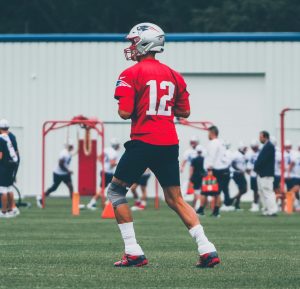
If he isn’t universally considered the greatest football player of all time, he’s at least objectively the most successful. Supposedly, one of Tom Brady’s secrets to success was an extremely strict diet, which was about 80% plant-based, organic, paleolithic, with abstinence from sugar, alcohol, soy, condiments, frozen foods, gluten, and nightshade vegetables.
Nightshade vegetables include white potatoes, tomatoes, eggplants, and bell peppers, and although all of these contain nutrients, they also contain a compound called solanine, a natural pesticide that can be toxic in high concentrations. People with irritable bowel, autoimmune, and/or arthritic conditions can be more vulnerable to solanine’s adverse effects—in Chinese medical terms, it creates dampness, or inflammation in the gut, which gets sent “outwards” to our joints. As someone who has battled gout disease off and on for twenty years, I’ve recently decided to experiment with nightshade abstinence. When it comes to self-experimentation, I generally recommend and adhere to the rule of the life cycle of a red blood cell, which is 120 days, or about four months, so I’ll let you know how things are when I reach the finish line.
Potatoes are an easy workaround, since sweet potatoes are safe, not to mention healthier overall, and delicious. I’ll miss French fries, but I’m an adult, and let’s be honest, they’re probably one of the worst things we can possibly eat. Eggplant and peppers are generally easy to avoid, but tomatoes will be tough. I love sauce and meatballs, not to mention a good caprese salad as we approach the season, however I do not love any of these things as much as I do my internal organs. Potential workarounds in said Italian realm are sauceless meatballs (+olive oil), pesto sauces, or garlic and oil primaveras, the latter of which sans peppers of course.
In playing with diet, I’ve found the same benefit I once did when imposing creative restrictions on myself as a comedian many years ago. For example, at one point I chose to not do or write any jokes about race anymore, simply because they’d become so ubiquitous and hacky on the circuit. I got so bored of hearing them that I couldn’t bring myself to perpetuate the problem, no matter how unique I thought a particular idea of mine was. By “censoring” myself in this way I think I became a superior writer, forced to think harder and write more imaginatively. Similarly, when we omit certain foods from our diet, we might be forced to broaden our horizons (just use Google!), expand our minds and at-home menus, and probably discover new foods that we love, and more importantly love us in return.
If you suffer from any chronic joint pain, autoimmune, or intestinal condition I would invite you to join in my self-experiment and see how your body feels. You/we don’t have to commit to forever. Just four months to intelligently reassess. If you prefer to wait until after tomato season you can enjoy throughout the summer, begin after Labor Day, and resume nightshade indulgences again for the winter holidays. As humans go, it seems the second most common time of year to clean up our acts after New Year’s is the end of summer, in the wake of vacations, ballgames, beers, and barbeques.
None of us can become Tom Brady on the football field, but it would be nice if our internal organs and systems could be as close as possible to the Tom Brady’s of our bodies. As we weaken with age, I believe the most logical antidote is strength in discipline, in hopes of maximizing physical freedom through restrictions or subtraction. Less is more, as they say, a fine maxim to default to under the spell of American food.
Healing my Acute Ankle Sprain Overnight!
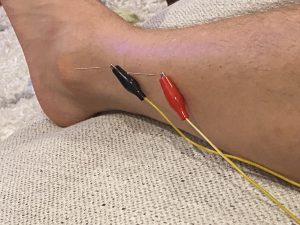 Every once in a while I am reminded, by way of my own personal suffering, of the incredible power of our medicine when we “nail it,” usually thanks to the healing hands of others, but sometimes even by “representing myself in court.”
Every once in a while I am reminded, by way of my own personal suffering, of the incredible power of our medicine when we “nail it,” usually thanks to the healing hands of others, but sometimes even by “representing myself in court.”
Thursday mornings are generally the most challenging at home. I have to leave a bit earlier to get to the school downtown and teach, which means I have to prepare breakfast and the baby’s things a bit faster, and often times endure her expressions of raging heartbreak when I must break out of the house shortly after she wakes up. Last week was one such morning.
As Jillian scrambled to get ready upstairs and I to prepare to leave downstairs, Peyton found herself in a “Daddy mode,” wanting me and only me, as my wife attempted to dress and brush teeth in hyper-speed so as to not leave our very mobile, curious toddler alone downstairs. Finally, it was 7:55, my hard out. I picked up the baby, carried her upstairs in hysterics, kissed her, set her down in front of my flustered wife, scrambled down the steps, and WHAM! Rolled my left ankle inward and exclaimed in pain in lieu of shouting “I love you,” on my way out.
I’d gotten lucky. On my walk to the train I realized the sprain or strain, or whatever had just happened must have been mild, as I felt only a mild twinge of pain at the ankle. I figured this should be a quick fix while watching TV later that evening.
But over the course of the day, I observed the pain grow gradually worse, and it wasn’t because I was standing or pounding on it excessively. To the contrary, supervising student clinic shifts is mostly sedentary and physically undemanding. By the end of the shift I was truly limping, to the point that it was difficult to get down the subway steps. By the time I got off the subway it was difficult to drag myself through the tunnel at Penn Station, requiring manual use of a wall to support my limp. And by the time I got off New Jersey Transit a half hour later I was in pain even at rest and could not apply any pressure to the foot whatsoever. In all of my youthful years skateboarding and playing soccer this was easily the worst sprain I’d ever had. I hopped down the stairs one step at a time and needed a ride home from the station.
As most of you know, I am a big believer that painkillers of any form should be relegated for pain—not discomfort—as my opinion is the laissez faire way in which they are ingested likely contributes over time to malabsorption in the gut, which is a primary etiology for many diseases. However, they do have their place, and this was one of them. With both sides of my ankle now throbbing, even while elevated on the couch, I ate some soup and took the max dosage of ibuprofen. From there the pain subsided and I returned to Chinese Medicine.
San Huang San is an empirical treatment for the first stage of such injuries. Nicknamed “herbal ice,” it reduces inflammation even more powerfully, but instead of constricting local blood circulation it enhances it, and I desperately wish all professional athletes knew about this ancient cure. I hopped into the kitchen, cracked an egg into a bowl, removed the yolk, and poured the herbal powder in with the white part to make a poultice. Stirring, stirring, stirring furiously, while my ankle pounded, pounded, pounded furiously with pain, I was determined to get back to the couch and begin this healing process as soon as possible.

Step 1: Bleed the “jing wells.” Jing well points are the first on each meridian, which means ends of the fingers and toes. It’s not always the most pleasurable experience, but pricking these points with a lancet to drain stagnated blood along the channel of physical trauma is a great way to begin the anti-inflammatory process by making space for new blood to come in. It’s a bit psychologically challenging to do on one’s self, but I managed, on the ends of both the big and fourth toes.
Next I used a spoon to apply my brown pasty, egg-white-based poultice to the entire ankle and wrapped it all up with bandages from our medicine cabinet. When the ibuprofen kicked in, I was no longer in pain at rest, but still was unable to put any weight whatsoever on the foot. That night I chose to sleep on the couch downstairs, as opposed to thunderously hopping up the steps and surely waking the baby.
Before bed I did acupuncture: Two points along the posterior tibial nerve pathway that innervates the medial malleolus (inner ankle), and two points along the peroneal longus and brevis respectively, which innervate the lateral malleolus (outer ankle). 15 minutes on each side, a protocol I was about to great practice in performing in the week to come.
I canceled my entire workday on Friday (sorry everyone), just praying that things would be manageable by Monday. When I woke up the next morning I was not in pain at rest, which meant I could put the Advil away for now. Before choosing to hop to the bathroom I thought I’d give a very light limp a try. I braced myself by my arm up against the living room wall and put the gentlest pressure I could muster onto the floor. No real pain. “Heyyy, that’s at least some improvement!” I took another step, this time cautiously applying even more pressure, and again noticed zero to minimal pain.
In my 20 years as a patient of Chinese Medicine, that walk from the couch to the bathroom was one of the most awe-inspiring, amazed experiences I’d ever had. With every step I applied more pressure and with every step I felt more gratitude and disbelief. I knew the reputation of San Huang San powder. I’ve used it on patients as well as on myself before, but I’d never seen it work at this speed with this degree of efficacy. My ankle was 80-90% better literally overnight. I almost thought twice about calling my patients to reschedule the afternoon, but with the help of a more level head from my better half I thought better of it and took the day to rest. Instead, and to satiate my Type A workaholism I purchased an online webinar by one of my mentors and spent the day studying. I am now one week removed from the sprain and feel 100% better.
Most people are aware of Chinese Medicine’s efficacy at treating chronic pain and injuries, but don’t realize that many such protocols, powders, formulas, and treatments were created and developed to treat injured soldiers in the ancient times of China’s warring states. Instead of the western RICE method, which even its creator, Dr. Gabe Mirkin, has conceded as wrong, please don’t hesitate to reach out the next time you sprain an ankle, break a bone, or tear a ligament. Like the smartphone saying, “There’s an app for that,” in Chinese Medicine we might echo, “There’s a treatment for that.”
Arthritis: What is the Cause & Cure?
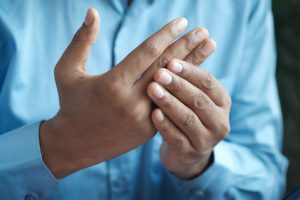
I can’t tell you how many times patients have either inquired to me about a cure for arthritis or informed me that there is no cure, that the cause is objectively unknown, and of course I must laugh to myself at the obtusity of the latter in the context of our dynamic.
First I want to reiterate, I am not one of those (alternative) medicine clinicians who believes biomedicine has no place, nor that my own paradigm of medicine can cure all. If someone has a brain tumor or stage 3 liver cancer they need a biomedical doctor—not me (though they’re best advised to utilize someone like me for complementary support).
I am, on the other hand, absolutely one of those alternative medicine clinicians who believes that biomedicine’s understanding of the human body is limited to structural and literal objectivities, wholly in neglect of its intangible dynamics of physiological substances. This is what Chinese Medicine is almost entirely predicated on, and more relevant to arthritis.
Synovial fluid surrounds our joints. Healthy body fluids surround everything, in perfect illustration of our microcosmic embodiment of the world we exist in. When fluid circulation is impaired it coagulates, like a traffic jam in the body, and equally frustrating to our global agendas. First fluids stick and accumulate, then to the point that they obstruct the thinner, healthy fluids from doing their job of lubricating the joint, creating the ironic illusion of dryness. We hear cracking and feel dry, and label arthritis as a “dry condition,” when in fact it is the opposite. Stress and fatigue, along with sugar, alcohol, dairy, gluten, raw/cold foods and drinks, all induce fluid accumulation, so is it any wonder how arthritis is rampant in the modern world?
Arthritis is very personal to me, as it was the first condition I attempted and failed at treating in my father, as an acupuncture student many years ago. Dad was a great dad, but his diet was poor, stress was high, and he drank daily for a very long time; not to mention that he had a son and student as his practitioner. I think we peaked at temporary relief of symptoms each week.
Conversely, I take great pride in my own management of the gout disease that I inherited from Dad. I was diagnosed with the men of our family’s condition at the premature age of 25, and after suffering several painful attacks many doctors told me that I should live on Allopurinol, or whatsoever was the drug being presently recommended. Instead, I went on to learn Chinese Medicine. I all but completely abstained from refined sugar (exceptions for holidays, birthdays, and Paris) and obviously follow a very Eastern diet. My stress and fatigue inevitably wax and wane, as goes life. I know gout is something I’ll always have to be mindful of, but the fact that I’m now 45 and have never lived on medications or with annual attacks is a feather in my cap.
Without dietary modifications arthritis cannot be cured, in my opinion. That doesn’t mean one has to be completely abstinent from all of the aforementioned usual suspects. Just that the diet should be highly impressive 90% of the time.
Without internal herbal medicine arthritis cannot be cured, in my opinion. Acupuncture is fantastic, but it is rarely powerful enough to break down fluid accumulations or deposits, or adequately restore metabolic function the way herbs can. As always, with herbs there is no one size fits all prescription, no “herbal allopurinol,” nor even one prescription that one would take throughout a course of treatment. As the body changes, the formula changes and adapts to the patient’s evolving presentation.
While organ function is being restored through internal medicine, acupuncture can be invaluable to pain relief and improving local circulation. Committed patients must come for regular treatments for 3-6 months and modify their diets. In the first month acupuncture and moxibustion should be used twice a week. In subsequent months, once a week, and eventually every other week is fine so long as we are consistent and accurate with herbal formulas.
There is my best explanation for the causes and cure for arthritis.
Thirst, Sweat, & Urine: What is Normal?
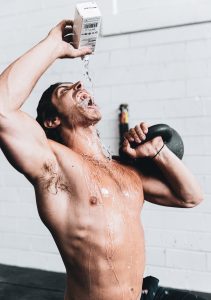
In contrast to the requisite ruling out of red flags by most nurses in conventional medical settings, the reason Chinese Medical practitioners ask about almost every system in your body is because we are diagnosing based on complete patterns—not just symptoms.
For example, if someone comes in for acid reflux, we cannot know their prescriptions until we know how often they urinate or poop, what each one is like, whether they experience headaches or dizziness, which part of the head they get their headaches in, how is their appetite, how thirsty they are during the day versus in the evening, etc. etc. This is because we are one of the only true forms of holistic medicine.
So, what is normal?
A normal amount of urination is approximately 6 times a day (yes, this includes waking at night). Much less than that and you are likely either retaining, or not drinking enough water in the first place. More than 6 indicates either a weakness in the urogenital microbiome, or excessive inflammation in the urogenital microbiome, which over time can lead to local weakness by putting strain on it. The remainder of the intake questions will determine which of the two is the case.
People should sweat, but not excessively so. Chinese Medicine is critical of HIIT or marathon training, hot yoga, and sauna therapy in most cases. While these might all feel great in the short-term and/or be proven to offer certain isolated benefits in the short-term, we believe they ultimately deplete the body’s healthy metabolic fluids. On the other hand, never sweating (exercising) at all is obviously just as harmful.
While some people barely break a sweat even when they exercise, others are drenched by the time they finish their morning commute, especially triggered by certain climates or seasons. The former can either indicate body fluid depletion or a malfunction of the immunological “qi.” The latter can either indicate inflammation, fluid retention, or also a malfunction of the immunological “qi.” This is where diagnoses and prescriptions get tricky.
Many western doctors have now begun to recognize the health benefits of the Chinese herb, astragalus, which on one hand is great. On the other hand, their recognition by way of empirical studies poses the challenge of having no comprehension of Chinese Medicine. If you give astragalus to the former example of a “cold-body person” with a simple immunological malfunction they will feel amazing and sing your praises. If you give it to someone with both immunological malfunction AND fluid deficiency it will do almost nothing. Worse, if you give it to a “hot-body person” with inflammation and fluid retention they will feel much worse.
Finally, it is normal to be thirsty, for 6-9 cups of water per day. A lack of thirst tells us there is fluid retention in the microbiome, signaling to the brain that it’s got plenty of liquid down here—no need to hydrate! This is dangerous, and better to fake it ‘til you make it in acquiring thirst. On the other pole are those who are ravenously or insatiably thirsty, which informs us of inflammatory heat in either their respiratory microbiome, gastrointestinal microbiome, or both, drying out their fluids. As always, the most complicated patterns are those who are generally unthirsty followed by sudden bouts of desperate thirst. This is a combination pattern that requires more thought, trial, and error.
I hope this was interesting and informative. One of western medicine’s shortcomings is its reliance on tests and labs to determine whether we are healthy or normal. While these are undeniably valuable, they tell only part of the story, which is why so many diseases get caught too late. Chinese Medicine is more brilliant in its neurotic recognition of pathologies in any abnormality, any imbalance, as something to rectify before it spirals into disease.
How Much Animal Protein Should I/We/U Eat?
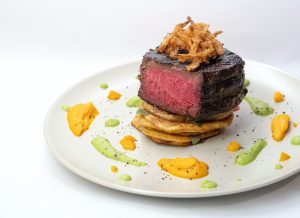
I got some great feedback from last week’s newsletter, not the least of which in the form of an inquiry and idea for elaboration on what is a “mindful” amount of animal protein for one to consume. Obviously, this is a subject of great debate—as are most dietary recommendations—and one Chinese medicine has strong opinions on.
Ironically, it was “The China Study” (2005) that prompted even greater popularity for vegetarianism, in spite of my understanding its conclusion was predicated on the assumption that if less is good, then none must be great. Traditional Chinese Medicine does not agree.
It would be impossible to know exactly how much animal protein is advisable for any one individual, but relatively easy to offer some general guidelines:
- Eat only wild fish, grass-fed or grass-finished meats, sans hormones or antibiotics. I recommend Whole Foods, Vital Choice, or Butcher Box.
- Eat more animal protein in winter and less in summer—approximately once a day in winter (in addition to eggs is fine, since eggs are light and easily digestible in the absence of any specific sensitivity) and 2-4 times a week in summer.
- Women should eat more red meat on their menses.
- Women should eat more red meat before, during, and after pregnancy.
- Elderly people need more animal protein than younger people.
- Everyone needs more animal protein after surgery, or after something like a marathon—basically any physical trauma.
- Animal protein should make up the smallest portion of food on your plate. In no way does this mean it should not appear on your plate, nor that its appearance is that of an allowable indulgence. Just that if each meal could be looked at as an herbal formula, the most beneficial dosage of steak would be smaller than that of broccoli.
- It is a kind gesture to say a quick prayer and thank the animal before consumption.
- People with a great deal of systemic “damp heat” should eat less animal protein than those with systemic “cold” and “blood deficient” constitutions. The challenge of course lies in that damp heat can dry out our body fluids and create blood deficiency, which causes us to require more meat. Also cold, over time, can create damp heat in the typical manifestation of inflammation as result of weakness.
How do you know who you are? It’s tough.
“Cold people” tend to have lesser appetites, more digestive complaints, and more frequent bowel movements. They’re rarely thirsty and rarely sweat, but they tend to sleep great.
“Damp heat people” tend to huge appetites, iron stomachs, and less frequent bowel movements, which doesn’t seem to bother them at all. They’re more likely ravenously thirsty and sleep is a great challenge.
Obviously, there are exceptions to these rules, but mostly as a result of one pathology lingering chronically for long enough to complicate the pattern by engendering its opposite. This is what makes real medicine so challenging. In school we learn case studies as if people are one or the other—either warm or cold-bodied—then we get into practice and quickly realize if only it were so simple. People are complex. So are our bodies, which means so should be its fuel sources.
I love my vegan friends, I respect vegetarianism for ethical reasons, but per usual, I believe that Chinese Medicine’s more moderate and discerning perspective on diet is most logical.


